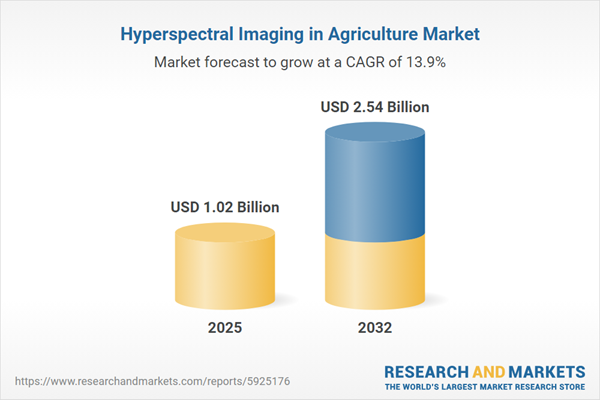Speak directly to the analyst to clarify any post sales queries you may have.
The Hyperspectral Imaging in Agriculture Market is evolving rapidly, empowering agricultural leaders to make data-driven decisions that drive productivity, sustainability, and strategic growth. This comprehensive report presents detailed analysis and actionable insights, supporting industry stakeholders in capitalizing on the latest innovations within the hyperspectral imaging ecosystem.
Market Snapshot: Hyperspectral Imaging in Agriculture
The Hyperspectral Imaging in Agriculture Market grew from USD 896.65 million in 2024 to USD 1.02 billion in 2025, and is projected to expand at a CAGR of 13.92%, reaching USD 2.54 billion by 2032. This strong growth reflects increasing adoption across key markets, driven by advanced sensing technologies and growing demand for precise multispectral insights in crop health monitoring, yield assessment, and sustainability initiatives.
Scope & Segmentation of the Hyperspectral Imaging in Agriculture Market
- Application Areas: Crop health monitoring, precision farming, soil analysis, and yield prediction.
- Crop Health Monitoring: Growth stage analysis, nutrient deficiency detection, pest and disease monitoring.
- Precision Farming: Disease detection, fertilizer management, variable rate irrigation.
- Soil Analysis: Moisture content analysis, salinity detection, soil composition mapping.
- Yield Prediction: Spectral modeling, temporal analysis, yield estimation models.
- Platform Types: Airborne deployments (helicopter, manned aircraft), satellite platforms (CubeSat, microsatellite), UAVs (fixed wing, rotary wing).
- End User Categories: Agribusiness companies (including food processors and input suppliers), farmers (large and small-scale operations), government research institutes (agencies, universities).
- Sensor Modalities: Pushbroom (SWIR, VNIR), snapshot (filter wheel, spectral filter mosaic), whiskbroom.
- Regional Segments: Americas (North America, Latin America), Europe, Middle East & Africa, and Asia-Pacific, with coverage of countries such as the United States, Canada, Brazil, Germany, China, India, and more.
Key Takeaways for Senior Decision-Makers
- Hyperspectral imaging delivers enhanced diagnostic capabilities, allowing early detection of crop stress, pests, and nutrient imbalances to inform timely interventions.
- Recent advances in sensor resolution and miniaturized platforms are promoting wider adoption, enabling integration in both large-scale and resource-constrained farming contexts.
- Data-driven innovations, including AI-powered analytics, are streamlining the transformation of raw spectral data into actionable intelligence at the field level.
- Platform versatility, with the use of airborne, satellite, and UAV-based systems, supports both broad-area surveillance and focused, high-resolution analysis.
- Market segmentation across applications, users, and regional needs ensures that stakeholders can select tailored solutions for maximum operational impact.
Tariff Impact: Navigating Equipment Costs and Regional Supply Chains
Recent tariffs imposed in the United States on hyperspectral imaging equipment have increased costs and influenced procurement timelines. These measures have prompted market participants to evaluate alternative sourcing and manufacturing strategies, including expanded domestic production and collaborative initiatives for localized assembly. Over time, these shifts have catalyzed more resilient supply chains and fostered partnerships among industry vendors, government agencies, and research institutes.
Methodology & Data Sources
This report integrates primary insights from industry executives, agronomists, and researchers with detailed secondary analysis of technical literature and public case studies. Segmentation and performance assessments are informed by a balanced mix of qualitative and quantitative research, with findings validated through expert review and cross-functional scenario planning.
Why This Report Matters for Hyperspectral Imaging in Agriculture
- Gain a clear understanding of technology trends, market drivers, and adoption dynamics across application, platform, and regional segments.
- Use data-backed analyses and best practices to inform investment, procurement, or partnerships in a rapidly transforming marketplace.
- Identify leading solution providers and benchmark against strategic actions taken by competitors, research bodies, and policy stakeholders.
Conclusion
Senior leaders can leverage this research to inform sustainable technology initiatives, optimize operational workflows, and adapt to a dynamic market influenced by innovation and policy. Strategic use of hyperspectral imaging will be a differentiator for forward-focused agricultural organizations.
Additional Product Information:
- Purchase of this report includes 1 year online access with quarterly updates.
- This report can be updated on request. Please contact our Customer Experience team using the Ask a Question widget on our website.
Table of Contents
3. Executive Summary
4. Market Overview
7. Cumulative Impact of Artificial Intelligence 2025
Companies Mentioned
The companies profiled in this Hyperspectral Imaging in Agriculture market report include:- Headwall Photonics, Inc.
- Spectral Imaging Ltd.
- Corning Incorporated
- Cubert GmbH
- Resonon, Inc.
- BaySpec, Inc.
- Teledyne DALSA Inc.
- Telops Inc.
- Photonfocus AG
- XIMEA GmbH
Table Information
| Report Attribute | Details |
|---|---|
| No. of Pages | 188 |
| Published | October 2025 |
| Forecast Period | 2025 - 2032 |
| Estimated Market Value ( USD | $ 1.02 Billion |
| Forecasted Market Value ( USD | $ 2.54 Billion |
| Compound Annual Growth Rate | 13.9% |
| Regions Covered | Global |
| No. of Companies Mentioned | 11 |









